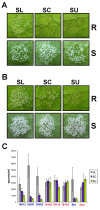Breakdown of resistance to grapevine downy mildew upon limited deployment of a resistant variety
- PMID: 20633270
- PMCID: PMC3095292
- DOI: 10.1186/1471-2229-10-147
Breakdown of resistance to grapevine downy mildew upon limited deployment of a resistant variety
Abstract
Background: Natural disease resistance is a cost-effective and environmentally friendly way of controlling plant disease. Breeding programmes need to make sure that the resistance deployed is effective and durable. Grapevine downy mildew, caused by the Oomycete Plasmopara viticola, affects viticulture and it is controlled with pesticides. Downy mildew resistant grapevine varieties are a promising strategy to control the disease, but their use is currently restricted to very limited acreages. The arising of resistance-breaking isolates under such restricted deployment of resistant varieties would provide valuable information to design breeding strategies for the deployment of resistance genes over large acreages whilst reducing the risks of the resistance being defeated. The observation of heavy downy mildew symptoms on a plant of the resistant variety Bianca, whose resistance is conferred by a major gene, provided us with a putative example of emergence of a resistance-breaking isolate in the interaction between grapevine and P. viticola.
Results: In this paper we describe the emergence of a P. viticola isolate (isolate SL) that specifically overcomes Rpv3, the major resistance gene carried by Bianca at chromosome 18. We show that isolate SL has the same behaviour as two P. viticola isolates avirulent on Bianca (isolates SC and SU) when inoculated on susceptible plants or on resistant plants carrying resistances derived from other sources, suggesting there is no fitness cost associated to the virulence. Molecular analysis shows that all three isolates are genetically closely related.
Conclusions: Our results are the first description of a resistance-breaking isolate in the grapevine/P. viticola interaction, and show that, despite the reduced genetic variability of P. viticola in Europe compared to its basin of origin and the restricted use of natural resistance in European viticulture, resistance-breaking isolates overcoming monogenic resistances may arise even in cases where deployment of the resistant varieties is limited to small acreages. Our findings represent a warning call for the use of resistant varieties and an incentive to design breeding programmes aiming to optimize durability of the resistances.
Figures





References
-
- Johnson R. A critical analysis of durable resistance. Annu Rev Phytopathol. 1984;22:309–330. doi: 10.1146/annurev.py.22.090184.001521. - DOI
-
- Parlevliet J. Durability of resistance against fungal, bacterial and viral pathogens; present situation. Euphytica. 2002;124:147–156. doi: 10.1023/A:1015601731446. - DOI
-
- Wolfe M. The current status and prospects of multiline cultivars and variety mixtures for disease resistance. Ann Rev Phytopathol. 1985;23:251–273. doi: 10.1146/annurev.py.23.090185.001343. - DOI
Publication types
MeSH terms
LinkOut - more resources
Full Text Sources
Other Literature Sources
Miscellaneous

